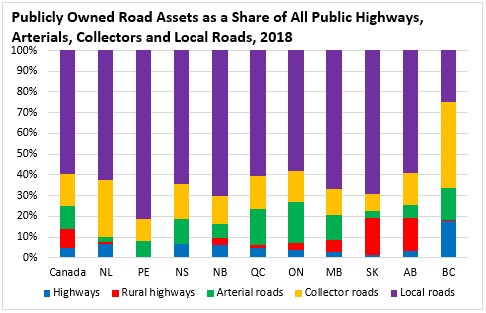The Economics and Statistics Division maintains archives of previous publications for accountability purposes, but makes no updates to keep these documents current with the latest data revisions from Statistics Canada. As a result, information in older documents may not be accurate. Please exercise caution when referring to older documents. For the latest information and historical data, please contact the individual listed to the right.
<--- Return to Archive
For additional information relating to this article, please contact:
October 26, 2020INFRASTRUCTURE: ROADS AND BRIDGES, 2018 

Statistics Canada has released new infrastructure data on publicly owned roads and bridges for 2018. In 2018, Nova Scotia had 27,993 kilometres of publicly owned highways and roads, up 3.2 per cent compared to 2016.
Across Canada, Prince Edward Island tops all other provinces in terms of its proportion of local roads, while British Columbia has the highest proportion of highways. The majority of rural highways are located in the Prairies. Most public roadway in Nova Scotia is classified as local roads (64%), collector roads (17%) and arterial roads (12%).

The Atlantic provinces have a notably higher portion of provincially owned local roads compared to other provinces. In 2018, provincially owned local roads accounted for more than half of all public roadway in Nova Scotia, while across Canada provincially owned local roads accounted for only 4.7 per cent of all highways and roads on average. Most local roads across Canada are municipally owned, with local municipal roads accounting for 55.1 per cent of roadway in Canada in 2018. Municipally owned local roads accounted for only 9.8 percent of all roads in Nova Scotia in 2018.
Definitions:
- Highways are defined as roads that move high volumes of traffic and have controlled entrance and exit, a dividing strip between the traffic in opposite directions, and typically two or more lanes in each direction. Highways do not provide access to property, and generally do not accommodate cyclists or pedestrians.
- Rural highways are defined as roads that move varied traffic volumes depending on location, are medium to high speed, and are usually one, but sometimes two lanes in each direction. These highways usually have no dividing strip and allow for direct access from adjacent developments.
- Arterial roads are defined as roads that move moderate to high traffic volumes over moderate distances between principal areas of traffic generation, and gather traffic from collector roads and local roads and move it to the highway system. Arterial roads are generally designed for medium speed, have capacity for 2 to 6 lanes, and may be divided, with limited or controlled direct access from adjacent developments and with on-street parking discouraged.
- Collector roads are defined as roads that move low to moderate traffic volumes within specific areas of a municipality and collect local traffic for distribution to the arterial or highway system. Collector roads are generally designed for medium speed, have capacity for 2 to 4 lanes, are usually undivided, with direct access from adjacent development permitted but usually controlled, and with controlled on-street parking usually permitted.
- Local roads are defined as roads that provide for low volumes of traffic and access to private properties; local roads are designed for low speeds, have capacity for 2 undivided lanes of traffic; through traffic is discouraged and parking is usually permitted though often controlled.
Statistics Canada Tables:
Inventory of publicly owned road assets, Infrastructure Canada
Inventory of municipally owned road assets, by urban and rural, and population size, Infrastructure Canada
<--- Return to Archive